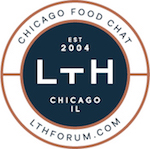Art and Appetite: American Painting, Culture, and Cuisine
Art and Appetite: American Painting, Culture, and Cuisine
-
-
-
-
-
Art and Appetite: American Painting, Culture, and Cuisine
-
Post #1 - October 16th, 2013, 10:41 pmArt and Appetite: American Painting, Culture, and Cuisine
Tuesday, November 12, 2013–Monday, January 27, 2014
Regenstein Hall @ Art Institute of Chicago
Elegant arrangements of cookies or cakes, lavish and overflowing arrays of fruits, or the remnants of a gluttonous feast—depictions of food in art certainly convey a passion for culinary delights. Yet, still-life paintings of edibles also speak volumes about their cultural context. American artists have used food to both celebrate and critique their developing society; express ideas relating to politics, race, class, gender, and commerce; and investigate American identity. This exhibition brings together over 100 paintings, sculptures, and decorative arts from the 18th through the 20th century, along with a selection of period cookbooks, menus, trade cards, and posters, to explore the art and culture of food and examine the many meanings and interpretations of eating in America.
From the earliest years of the United States, American artists such as Raphaelle Peale used still-life painting to express cultural, political, and social values, elevating the genre to a significant aesthetic language. In antebellum America, depictions of food highlighted abundance and increasing wealth. Elegant decanters of wine and spirits in still-life paintings by John F. Francis reflect the prevalence of drinking and the mid-century debates over temperance. During the Gilded Age, despite the implications of the term, American artists moved away from excess and eschewed high Victorian opulence in favor of painting the simple meal. Many artists, such as William Harnett or De Scott Evans, also used food pictures to serve up biting political commentary that addressed the social and economic changes of the 1880s and 1890s.
In the 20th century new ways of eating and socializing began to change depictions of food in art. Restaurant dining—still novel in the United States in the late 19th century—became a common subject in the works of William Glackens, John Sloan, and others. Café and cocktail culture became increasingly important, described in the work of Stuart Davis and Gerald Murphy, even as Prohibition banned the consumption of alcohol.
Finally, during the 1950s and 1960s, Pop artists Andy Warhol and Claes Oldenburg addressed the ways in which mass production and consumption dramatically altered the American experience of food. Hamburgers, fries, and cakes were painted as objects of mass-produced comestibles without human referent. Artists employed new means to express their distance from the tangible reality of food, the visual power of advertising, the standardization of American meals from factory-produced products, and the gluttony of American appetites.
Today as professional and home chefs increasingly turn toward local, organic food and American society ponders its history as a fast-food nation, this exhibition on the historical art of eating allows viewers to look at depictions of American food and culture with new meaning and fresh eyes.
Museum Hours
Open daily 10:30–5:00
Thursday until 8:00
The museum is closed Thanksgiving, Christmas, and New Year's Day.
Free Thursday Evenings
Admission to the Art Institute of Chicago is free to Illinois residents every Thursday from 5:00 to 8:00 p.m.Cathy2
"You'll be remembered long after you're dead if you make good gravy, mashed potatoes and biscuits." -- Nathalie Dupree
Facebook, Twitter, Greater Midwest Foodways, Road Food 2012: Podcast
-
-
Post #2 - November 19th, 2013, 2:17 pm
Recipes and additional exhibit information can be found here:
http://extras.artic.edu/artandappetite/ ... he-curatorCathy2
"You'll be remembered long after you're dead if you make good gravy, mashed potatoes and biscuits." -- Nathalie Dupree
Facebook, Twitter, Greater Midwest Foodways, Road Food 2012: Podcast
-
-
Post #3 - December 19th, 2013, 9:53 amHi,
This evening at 6:00 pm, noted food historian Andy Smith will speak at the Art Institute.
Culinary historian Andrew Smith discusses gustatory explorers with connections to Art and Appetite. Andy is a frequent speaker at Culinary Historians. He does a fine job weaving together food history into an interesting and entertaining narrative.
Just a bit more information here: http://www.artic.edu/event/lecture-ingr ... n-appetite
Free Thursday Evenings
Admission to the Art Institute of Chicago is free to Illinois residents every Thursday from 5:00 to 8:00 p.m.
Regards,Cathy2
"You'll be remembered long after you're dead if you make good gravy, mashed potatoes and biscuits." -- Nathalie Dupree
Facebook, Twitter, Greater Midwest Foodways, Road Food 2012: Podcast
-
-
Post #4 - January 3rd, 2014, 11:49 pmArt Institute Member Book Club: “The Food of a Younger Land”
January 23, 2014
6:00pm–7:30pm
Ryan Education Center, Studio A
Free for members
Reading Between the Lions returns with Mark Kurlansky's The Food of a Younger Land, chosen to complement the exhibition Art and Appetite: American Painting, Culture, and Cuisine.
Reservations are required for this program.
For additional member programs, please visit the member programs calendar. For additional information, please call (312) 499-4111.
Discussion guide: www.artic.edu/sites/default/files/bookc ... d_2013.pdfCathy2
"You'll be remembered long after you're dead if you make good gravy, mashed potatoes and biscuits." -- Nathalie Dupree
Facebook, Twitter, Greater Midwest Foodways, Road Food 2012: Podcast
-
-
Post #5 - January 7th, 2014, 12:26 pmRemember, the exhibit closes at the end of January. From January 6 through February 12, admission to the Art Institute is free to Illinois residents all day every weekday.

